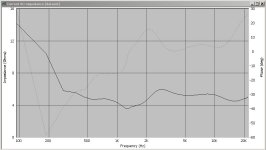This is the calculated impedance of a speaker crossover design I'm working on (the individual driver impedances are the measured values). This is just a midrange and tweeter, the amp will have a line level crossover at 450-500Hz so it won't be playing anything below that. Also, this graph doesn't have too many data points below 1K, so take the low frequency region with a grain of salt.
The amp is an SE 2A3, using One Electron UBT-3 OPT's (which is a 3kOhm transformer). I'm using Sovtek 2A3s and driving them slightly hot (~65-70mA), if that makes any difference. The 8 ohm taps are currently connected.
I'll wait till I have real measurements of the final crossover before changing the taps on the OPTs, but I'd like some advice on whether this would be considered a nominal 4 ohm speaker load or not. It seems to me that it should be, it's between 4 and 6 ohms over the region I'm interested in (and even dips a little below 4 at one point).
Also, I understand the general rule of thumb of putting this speaker load on the 8 ohm tap - power output goes up, distortion goes up. Anything else I should keep in mind? Does the fact that I'm driving the tubes slightly hot make any difference here?
Thanks,
Saurav
The amp is an SE 2A3, using One Electron UBT-3 OPT's (which is a 3kOhm transformer). I'm using Sovtek 2A3s and driving them slightly hot (~65-70mA), if that makes any difference. The 8 ohm taps are currently connected.
I'll wait till I have real measurements of the final crossover before changing the taps on the OPTs, but I'd like some advice on whether this would be considered a nominal 4 ohm speaker load or not. It seems to me that it should be, it's between 4 and 6 ohms over the region I'm interested in (and even dips a little below 4 at one point).
Also, I understand the general rule of thumb of putting this speaker load on the 8 ohm tap - power output goes up, distortion goes up. Anything else I should keep in mind? Does the fact that I'm driving the tubes slightly hot make any difference here?
Thanks,
Saurav
Attachments
Hard question to answer, certainly with lower impedance primaries the 4 ohm tap might be better, but in a region where either tap may work reasonably well you'll have to try it to see which one provides the best overall performance.
Note that it is not a bad idea to figure out what the amplifier's output impedance is on each tap and using that in the design of your x-o . It's less critical with mids and tweeter drivers, but unlike the nearly perfect voltage source of a solid state amplifier where the two networks are practically speaking independent of each other, with a tube amplifier there can be interaction between the components in the two filter sections of the x-o, their speaker loads, and the amplifier.
The Audio Precision website had a good article on measuring amplifier source impedance based on changes in output voltage loaded and unloaded.
Note that it is not a bad idea to figure out what the amplifier's output impedance is on each tap and using that in the design of your x-o . It's less critical with mids and tweeter drivers, but unlike the nearly perfect voltage source of a solid state amplifier where the two networks are practically speaking independent of each other, with a tube amplifier there can be interaction between the components in the two filter sections of the x-o, their speaker loads, and the amplifier.
The Audio Precision website had a good article on measuring amplifier source impedance based on changes in output voltage loaded and unloaded.
Myself I would go with the Four Ohm tap...The bulk of signal "information" is going to be in the midrange of the scale. And as in your chart that impedence is running at Appx. six ohms. The four Ohm would be the safest choice. As Kevin notes there are almost countless variables to consider.......that's why we have our composite "averages".
The rising impedence at the lower end is of course the Back EMF of the resonant frequency of the midrange, (Probably cone type..6"?)
_______________________________________--Rick....
The rising impedence at the lower end is of course the Back EMF of the resonant frequency of the midrange, (Probably cone type..6"?)
_______________________________________--Rick....
- Status
- This old topic is closed. If you want to reopen this topic, contact a moderator using the "Report Post" button.
